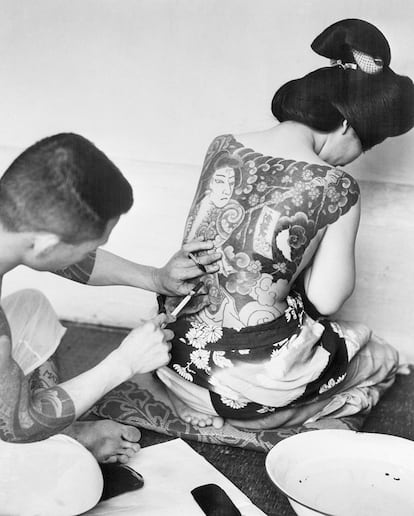Two literary treasures to delve into Japanese crime fiction

A type of opinion piece that describes, praises, or criticizes, in whole or in part, a cultural or entertainment work. It should always be written by an expert in the field.

Japanese noir is a universe unto itself. Like so many other aspects of the Asian country, its authors reach us in dribs and drabs and with a high degree of fascination. There have been major successes, including novels by Seicho Matsumoto ( Tokyo Express and The Girl from Kyusu , to name just two published by Libros del Asteroide), the gory, too much for my taste, Miso Soup by Ryu Murakami (published by Malas Tierras), and one of the all-time great detective novels : 64 by Hideo Yokoyama (Salamandra).
Today we bring you two fine examples of the genre's diversity in Japan. They're also two classics coming to the Spanish market for the first time. And they couldn't be more different. Come in and read.
Four Criminal Cases , Junichiro Tanizaki (Satori, translated by Rumi Sato). He doesn't belong to the tribe of crime fiction writers, but he does belong to the eternal Nobel Prize candidates and to the best Japanese writers of the 20th century . Here, Tanizaki (1886-1965) goes to great lengths to deliver four stories that honor the genre in a very careful edition, his trademark. The result is uneven, but the gamble is worth it. The first, The Yanagi Bath Case (1918), uses the unreliable narrator (a young man with mental problems who confesses to a crime) and the framed narrative strategy (a narrator witnesses the confession and is the one who opens and closes the story), but he doesn't achieve the desired effects, at least for the reader who speaks to them. Perhaps it's because there is a crime, but it's more of a horror story that doesn't quite come together. The second, on the other hand, On the Road (1920), goes beyond the homage to detective novels and the deductive world of Sherlock Holmes. It creates a curious game: an investigator goes to pick up a man after work, whom he must ask a series of questions about his life to certify his suitability to marry his girlfriend. He has been hired by the in-laws, and that explains the initial purpose. But brilliantly, and with a character that would unnerve anyone, Tanizaki turns the situation on its head and finds a way to move the story forward for an astonished reader. Of the third, The Thief (1921), little can be said without spoiling it, so we'll stick with this: it is several years ahead of a solution that the master Agatha Christie found for one of her best novels (although the story doesn't live up to that). And the last, Devils in Daylight (1918), is the most complex and interesting because the narrative weave it encapsulates, the trap the protagonist falls into, and the final outcome are all of a high standard. And, unlike the first two, the main female character is not a mere ornament.

The Mystery of the Tattooed Woman , by Akimitsu Takagi (Salamandra, translated from English by Eduardo Hojman). 1947 Tokyo, a devastated and hopeless city, serves as the setting for this novel that draws heavily on the spirit of classic Western detective novels (including some meta-literary references that fans will love). With the traditional calm of the Japanese genre, the author first immerses us in the cult of tattoos as a sublime (and at the time prohibited) art through a woman, Kinue Nomura, fascinating and dark in equal measure. The weight of the narrative is carried by Kenzo, a forensic doctor in love with Kinue and brother of Daiyu, one of the stars of the Tokyo police force as an investigator for the criminal squad. A series of ritual murders related to tattoos unleashes the brothers' investigative action and opens the door to a fascinating underworld. The procedural elements (autopsies, interrogations, investigators' deductions, etc.) are told with precision and incredible timing, somewhere between the best literature and a police report. The way it includes the character who will unblock the investigation and how he uses chess and Go to uncover the weaknesses of several suspects is original and entertaining. There are no big surprises or spectacular twists, because this isn't a novel of that style, nor does it need them, but there is a steady pace that leads to an ending in keeping with this whole artifact.
This is the first time this 1948 classic has reached Spanish bookstores. We look forward to more works by the genius Akimitsu Takagi.
EL PAÍS

%3Aformat(jpg)%3Aquality(99)%3Awatermark(f.elconfidencial.com%2Ffile%2Fbae%2Feea%2Ffde%2Fbaeeeafde1b3229287b0c008f7602058.png%2C0%2C275%2C1)%2Ff.elconfidencial.com%2Foriginal%2Fe17%2F954%2F2a7%2Fe179542a7263afa17f216b52bcbda947.jpg&w=3840&q=100)
%3Aformat(jpg)%3Aquality(99)%3Awatermark(f.elconfidencial.com%2Ffile%2Fbae%2Feea%2Ffde%2Fbaeeeafde1b3229287b0c008f7602058.png%2C0%2C275%2C1)%2Ff.elconfidencial.com%2Foriginal%2Fd77%2F6df%2Fe35%2Fd776dfe3577cca4e74685f922935bdb4.jpg&w=3840&q=100)
%3Aformat(jpg)%3Aquality(99)%3Awatermark(f.elconfidencial.com%2Ffile%2Fbae%2Feea%2Ffde%2Fbaeeeafde1b3229287b0c008f7602058.png%2C0%2C275%2C1)%2Ff.elconfidencial.com%2Foriginal%2F968%2F0f2%2F544%2F9680f25447f3ed5d1ffdbfdd26692a2e.jpg&w=3840&q=100)
%3Aformat(jpg)%3Aquality(99)%3Awatermark(f.elconfidencial.com%2Ffile%2Fbae%2Feea%2Ffde%2Fbaeeeafde1b3229287b0c008f7602058.png%2C0%2C275%2C1)%2Ff.elconfidencial.com%2Foriginal%2F951%2Fac4%2F545%2F951ac454527bd21397aedfb748c019b9.jpg&w=3840&q=100)
